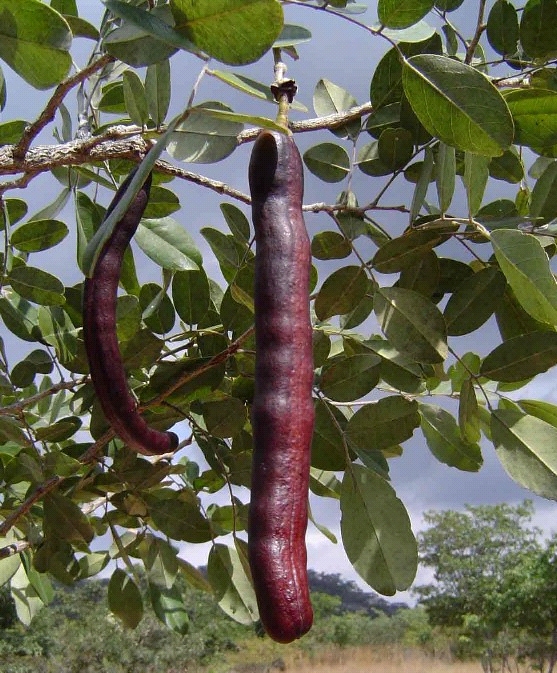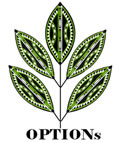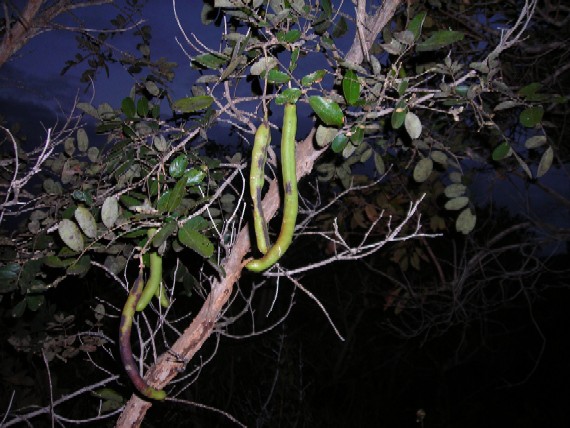Bobgunnia madagascariensis
Distribution and habitat
It is found in semi-arid tropical Africa, from Senegal and Zambia to Central African Republic and below the rainforest belt from Democratic Republic of Congo to Tanzania, Namibia, Botswana and Mozambique. It is not found in Madagascar. It grows at 150-1750 m altitude, in sandy or clay-loam soils in valleys and humid plains and in open deciduous woodland and grassland.
Flowering and fruiting habits
Semi deciduous small tree, height up to 15m, multi-stemmed, with one bole up to 60 cm in diameter. The grey bark surface is ridged, flaking off, with a yellowish white inner bark, with crimson black mucilage. The crown is dense and rounded. Leaves alternate, rounded at both ends, compound with (3-)5-9(-13) leaflets, petiole 2-4cm long. Terminal or axillary inflorescence, raceme up to 8cm long, with 2-14 flowers which are bisexual, zygomorphic, sweet scented, white with grey margin and yellow at base, numerous yellow stamens, and ovary superior. The fruit is a brown woody long pod up to 30 cm, with 10-15 seeds which are flat oblong. Epigeal germination of seedling. Flowering occurs with new leaves in South Africa in September-November, in Ghana around April-May and in Cameroon in February-April. Seeds are released from fruits and fall to the ground.
Uses other than pesticidal
Wood- For poles and posts for houses and fence. Wood for furniture, musical instruments, tool handles, flooring, joinery, heavy construction. Slow burning firewood and charcoal making.
Traditional medicine- Fruits used to treat bilharzia, leprosy and ear ache. Roots used to counteract venomous stings and bites, venereal diseases, cataract and dysentery. Leaves used for headache and against cough. Bark used to treat diarrhoea, dysentery and as a disinfectant.
Fibre- Bark used to make bark cloth in Malawi and to obtain fibre for various purposes.
Propagation and cultivation
Soak B. madagascariensis seeds on hot water for 10 minutes, cool for 24 hours, and then germinate. Propagation by stem cuttings and root suckers also possible.
Seed collection & Storage
Seeds are released from inside the fruits when they fall to the ground and rot.
Seeds stay viable for several years if kept dry and insect free.
Parts used
Seed pods
Preparation
Grind seed pods to powder
Uses
Toxic
Can be used both pre- and post-harvest
Target organisms
Against broad range of insects; termites, weevils
Usually a small deciduous tree, 3-4 m in height. Stems and branches often much twisted and contorted; bark dark grey rough and fissured. leaves imparipinnate with 5-11 alternate to subopposite leaflets; leaflets elliptic to obovate, 2.5-7 cm, leathery, dark green and hairless above, yellowish velvety below. Flowers in lax 2-10-flowered sprays, with one large white petal and a mass of orange yellow stamens, sweetly scented. Pod cylindric, up to 30 cm, dark brown to black when ripe, indehiscent. Found in deciduous woodland and wooded grassland, often on sandy soils throughout tropical and southern Africa.

Photo credit: Bart Wursten, http://www.zimbabweflora.co.zw


